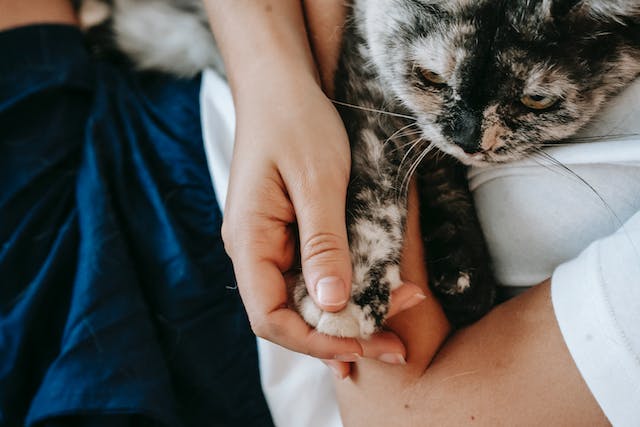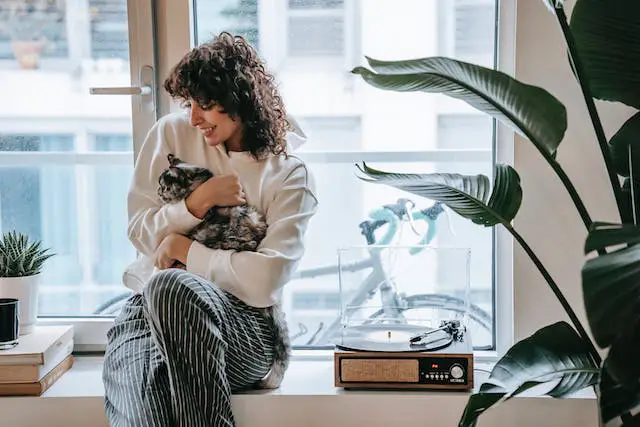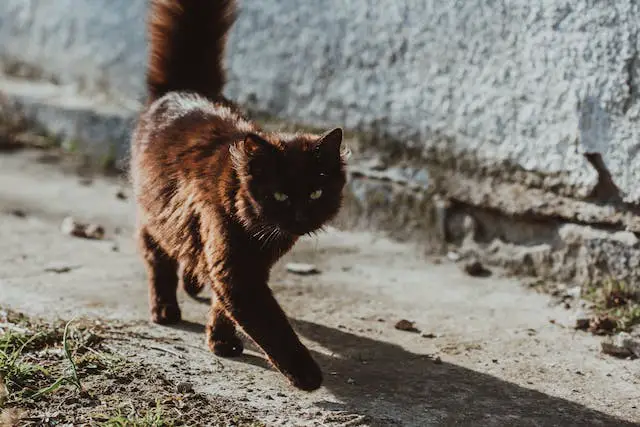Have you noticed your old feline friend having trouble keeping their balance lately? Don’t worry, you’re not alone.
In this blog post, we’ll dive into the common issue of old cats losing their balance and explore some tips to help them regain their stability and strut their stuff like the cool cats they are.
So, let’s get this old cat balancing act started!
Why is my old cat losing balance?
An old cat may be losing balance due to a medical condition such as vestibular disease, which affects the inner ear and can cause balance problems.
Another possibility is that it could be a result of age-related changes, such as arthritis or muscle weakness, which can affect a cat’s ability to maintain balance
As cats age, they may experience a decline in their overall coordination and balance. This can be attributed to a variety of factors, including muscle weakness, joint stiffness, and even neurological issues.
It’s important to consult with your veterinarian to determine the underlying cause and discuss potential treatment options.
Let’s dive deeper for a better understanding…
Common Causes of Loss of Balance in Old Cats

Here are some of the most common causes of loss of balance in old cats:
1. Age-Related Vestibular Disease
Age-related vestibular disease is a common cause of loss of balance in old cats.
It occurs when the vestibular system, which is responsible for maintaining balance, becomes impaired due to age-related degeneration.
The symptoms of age-related vestibular disease include head tilting, unsteady gait, circling, and difficulty with coordination.
To help an old cat with this condition, it is important to provide a safe and comfortable environment. Avoid sudden movements or changes in the cat’s surroundings.
Provide support and assistance when needed, and ensure that the cat has easy access to food, water, and a litter box.
In severe cases, medication may be prescribed by a veterinarian to alleviate symptoms and manage the condition.
2. Middle-Ear or Inner Ear Infections
Middle-ear or inner ear infections are one of the causes of loss of balance in old cats.
These infections can occur due to bacterial or viral invasion, leading to inflammation and fluid accumulation in the ear.
The infection affects the vestibular system, which is responsible for maintaining balance.
Symptoms of a middle-ear or inner ear infection in cats may include head tilting, stumbling, circling, and difficulty walking.
To help the old cat, it is essential to seek veterinary care for diagnosis and appropriate treatment, which may include antibiotics or antiviral medications.
Providing a comfortable and safe environment for the cat, with minimal obstacles and a stable living space, can also aid in their balance recovery.
3. Disease or Injury of the Spinal Cord
Disease or injury of the spinal cord can be a cause of loss of balance in old cats.
This can occur due to degenerative conditions such as intervertebral disc disease or trauma to the spinal cord.
When the spinal cord is affected, it disrupts the communication between the brain and limbs, resulting in balance issues.
To help an old cat with this condition, it is crucial to seek veterinary care for proper diagnosis and treatment.
Treatment options may include medication, physical therapy, or surgery, depending on the severity of the condition.
Creating a safe environment for the cat by removing obstacles and providing easy access to food, water, and litter boxes can also aid in improving their balance and overall well-being.
4. Damage or Disease of the Central Nervous System
Damage or disease of the central nervous system can be a common cause of loss of balance in old cats.
This can occur due to various conditions such as strokes, tumors, or degenerative diseases like vestibular syndrome.
These conditions disrupt the normal functioning of the brain and spinal cord, leading to balance problems.
To help an old cat experiencing loss of balance, it is important to first consult a veterinarian for a proper diagnosis.
Treatment options may include medications to manage underlying conditions, physical therapy to improve balance and coordination, and environmental modifications to prevent accidents.
Providing a safe and comfortable environment, with easy access to food, water, and litter boxes, can also help support the well-being of an old cat with balance issues.
5. Neurological Disorders
Neurological disorders can contribute to the loss of balance in old cats. These disorders can affect the cat’s brain, spinal cord, or nerves, disrupting their ability to coordinate movements.
The most common neurological disorders in older cats include vestibular disease and peripheral neuropathy.
Vestibular disease affects the inner ear and can result in symptoms like head tilt, unsteady gait, and difficulty maintaining balance.
Peripheral neuropathy affects the nerves in the limbs, leading to weakness and instability. To help an old cat with balance issues, it’s crucial to consult a veterinarian for a proper diagnosis and treatment plan.
Treatment options may include medication, physical therapy, and environmental modifications to provide a safe and supportive environment for the cat.
6. Exposure to Specific Drugs or Toxins
Exposure to specific drugs or toxins can cause a loss of balance in old cats. This can occur when cats accidentally ingest substances such as medications, household chemicals, or toxic plants.
These substances can disrupt the cat’s nervous system, leading to coordination and balance issues. If you suspect your old cat has been exposed to a drug or toxin, it is crucial to seek immediate veterinary assistance.
The veterinarian will evaluate the cat’s condition and may administer treatments such as decontamination, supportive care, or antidotes to counteract the effects of the substance.
Early intervention is vital in helping the old cat recover and regain its balance.
7. Feline Infectious Peritonitis (FIP)
Feline Infectious Peritonitis (FIP) is a viral disease that can cause loss of balance in old cats. It occurs when a cat is infected with a strain of the feline coronavirus.
The virus typically affects the cat’s abdomen, causing inflammation in the lining of the abdomen and other organs.
In some cases, the virus can also affect the central nervous system, leading to neurological symptoms such as loss of balance.
Unfortunately, there is no cure for FIP, and treatment focuses on managing the symptoms and providing supportive care.
8. Old Age Changes
Old age changes can contribute to the loss of balance in old cats. As cats age, their joints may become stiff and less flexible, affecting their ability to maintain balance.
Additionally, their vision and hearing may deteriorate, further compromising their balance.
To help an old cat with balance issues, it is essential to provide a safe environment by removing potential hazards and providing stable surfaces for them to walk on.
Regular veterinary check-ups are crucial to monitor any underlying health conditions that may be contributing to the balance problems.
Additionally, incorporating gentle exercises and physical therapy can help improve muscle strength and coordination in older cats.
9. Metabolic Diseases
Metabolic diseases can be a contributing factor to the loss of balance in old cats. These diseases, such as diabetes or hyperthyroidism, can affect the cat’s nervous system and lead to coordination problems.
As the disease progresses, it can cause weakness, muscle wasting, and neuropathy, which further impairs balance.
To help the cat, it is crucial to consult with a veterinarian for an accurate diagnosis. Treatment options may include medication, dietary changes, and managing the underlying metabolic condition.
Additionally, providing a safe and comfortable environment for the cat, with easy access to food, water, litter box, and low platforms, can help minimize falls and support their mobility.
10. Muscle Weakness
Muscle weakness is one of the causes of loss of balance in old cats. As cats age, their muscles naturally weaken, making it more challenging for them to maintain their balance.
This can result in wobbling, stumbling, or falling over. To help an old cat experiencing muscle weakness, there are a few things you can do.
First, ensure that the cat’s environment is safe and free from hazards that could lead to falls. Second, consider providing support devices such as ramps or steps to assist the cat in navigating elevated surfaces.
Third, encourage gentle exercise to help strengthen the cat’s muscles. Regular play sessions or short walks can be beneficial.
Finally, consult with a veterinarian to explore any underlying health issues that may contribute to muscle weakness and discuss possible treatment options.
Read more about health problems in cats.
Home Care Tips for Old Cats Losing Balance

As cats age, they may experience a decline in their balance and coordination. This can be attributed to various factors such as arthritis, muscle weakness, or cognitive decline.
Providing a safe and comfortable environment for your senior cat is crucial to help them navigate their surroundings more easily. Here are some effective home care tips for old cats losing balance:
1. Provide a stable environment: Older cats may have difficulty maintaining their balance, so it’s important to create a safe and stable environment for them. Remove any potential hazards such as loose objects, fragile items, or slippery surfaces that could cause your cat to lose balance and fall. By keeping the living space clear and organized, you minimize the risk of accidents.
2. Slip-resistant surfaces: Older cats may struggle with traction on smooth surfaces like hardwood or tile floors. Placing non-slip mats or rugs in areas where your cat frequents, such as near their litter box, food bowls, or favorite resting spots, can provide better grip and stability. These mats or rugs should have a rubberized backing to prevent them from sliding.
3. Easy access to essentials: As cats age, they may find it challenging to climb or jump onto higher surfaces. Ensure that your cat’s essential resources, such as litter boxes, food bowls, and water dishes, are easily accessible on the same level. Placing them in locations that don’t require your cat to exert themselves excessively reduces the strain on their joints and helps them maintain their balance.
4. Low-sided litter boxes: High-sided litter boxes can be difficult for older cats to enter and exit, especially if they are experiencing balance issues. Opt for litter boxes with lower sides or consider using a litter box with an entrance cut out, allowing your cat to step in and out with ease. This accommodation makes it more comfortable for them to maintain their litter box habits.
5. Assistive devices: There are a variety of assistive devices available to support older cats with balance and mobility issues. Ramps or steps can be used to help them access higher surfaces like beds or sofas without the need to jump. These devices provide a gradual incline and reduce the risk of falls. Additionally, supportive harnesses or slings can provide extra stability when assisting your cat with movement, particularly when going up or down stairs.
6. Regular exercise: While older cats may have reduced energy levels, it’s still important to encourage gentle exercise to maintain muscle tone and joint flexibility. Engage your cat in interactive play sessions using toys that stimulate their natural hunting instincts. Gentle movements, such as batting at toys or chasing a laser pointer, can help keep them active and mobile. However, be mindful not to overexert your cat and always monitor their comfort levels during exercise.
7. Comfortable bedding: Providing your cat with comfortable and supportive bedding is essential, especially for cats with balance issues. Soft blankets or orthopedic beds can help alleviate pressure on their joints and provide a cozy spot for them to rest and sleep. Orthopedic beds are specifically designed to offer extra cushioning and support, which can be beneficial for cats with arthritis or muscle weakness.
Read more about identifying a sick cat.
Frequently Asked Questions
Should I be concerned if my old cat is losing balance occasionally?
Occasional bouts of imbalance in older cats can be fairly common. However, if you notice a persistent and significant decline in your cat’s balance, it’s advisable to seek veterinary attention. It could be indicative of an underlying health issue that requires medical intervention.
Can arthritis in cats cause balance problems?
Yes, arthritis can indeed contribute to balance problems in cats. This degenerative condition affects the joints, causing stiffness and discomfort, which can affect their ability to maintain proper balance. Your veterinarian can help develop a treatment plan to manage the arthritis and improve your cat’s balance.
Are there any other health conditions that can cause balance issues in older cats?
Besides arthritis, several other health conditions can lead to balance problems in older cats. These may include inner ear infections, vestibular disease, hyperthyroidism, or even certain types of cancer. It’s crucial to have your cat thoroughly examined by a veterinarian to determine the underlying cause.
Can medication help improve my old cat’s balance?
Depending on the underlying cause of your cat’s balance issues, your veterinarian may prescribe medication to help manage the condition. For example, anti-inflammatory drugs can alleviate arthritis-related discomfort, while antibiotics can address inner ear infections. Always follow your vet’s instructions and monitor your cat’s response to any prescribed medication.
Is there anything I can do at home to help my old cat with balance problems?
While it’s essential to consult with a veterinarian for proper diagnosis and treatment, there are a few things you can do at home to support your cat. Ensure their environment is safe and free from obstacles that could cause falls. You may also consider providing them with easily accessible litter boxes and food/water bowls. Additionally, providing gentle exercise and maintaining a healthy diet can contribute to overall well-being.
Read more about caring for cats.
Conclusion
In conclusion, when it comes to an old cat losing balance, it’s important to remember that they may be experiencing age-related changes that affect their coordination. Providing a safe and comfortable environment, regular vet check-ups, and gentle exercises can help support their overall well-being. Remember, with a little extra care and understanding, your aging feline companion can continue to enjoy a happy and fulfilling life.

